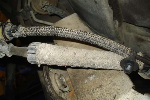Ok, I now understand what you're saying. I did not know that it worked that way, and now I'm curious and going to have to verify that from some other source (for my own fullfillment), not how the electrical nature works but the fact that they are "paired" I was under the impression that it was more each spark jumped the same way but I give you the fact that I am likely wrong, I just want to see for myself. And I am fully let me restate FULLY aware of the nature of a complete circuit and electron flow (opposite of charge, which ironically is how electrical calculations are typically done b/c it's easier and that's how we started doing it forever ago, but it works if you do it with electron flow, it's all about signs). Being a EE major and coming close to graduation will ingrain a lot of stuff into you. I do not however fully understand how vehicles are setup, so I'm sure your right, in which case I see how you could say single plats don't help, I don't FULLY agree, but I grant you your point. I guess really since single plats are still FREAKING CHEAP compared to anything else on a car, and they only really need to be changed every 60k miles, you might as well go with what Ford said, although i suppose by that nature double might be better, whatever, THANKS for the explanation though now my interest is peaked for learning (ARG and me on spring break not wanting to think)










